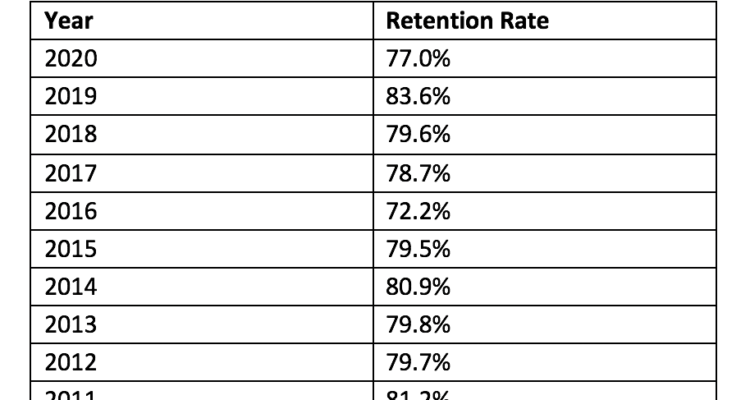By Dalila Bevab and Breanna Rahe
Bellarmine University’s Fall 2021 retention rate plummeted to 77%, and administrators are trying to identify why so many students left Bellarmine after their first year.
Dean of Student Success and International Programs Kristen Wallitsch said the retention rate is a “historical low,” although in 2016 it was 72.2%.
“If we can see students be successful in that first year and come back in that sophomore year, then there’s a high chance that they’re going to persist onto graduation,” Wallitsch said. “If we lose a student that first year, then the student may or may not come back, and that’s an ethical issue for us because we truly want to see all of our students succeed.”
Wallitsch said the Student Success Center did its best to offer services online last year but students got online fatigue. Although it doesn’t necessarily speak to why students did not come back to Bellarmine, it may explain why they did not participate in Student Success programming, she said.
Wallitsch said the university is seeing a rebound in students coming back and wanting to use services in-person. This year, she said she thinks the mask and vaccination requirement this year makes students feel more comfortable.
“We are seeing students return pretty strongly to our services this year, and we’re hoping that continues,” she said.
Multiple attempts were made to contact other small universities across Kentucky, including Centre College and Spalding University, to get their first-year enrollment and retention numbers for the 2021-2022 academic year but phone calls and email messages were not returned. Transylvania University reported its 2020 numbers to Knights Media Network. Megan Moloney, vice president of marketing and communications, said the fall retention rate was 82% and freshmen and transfer enrollment was 309.
Along with the retention rate, the overall enrollment rate declined as well. “Undergrad enrollment last fall was down 4%, and that trend will probably hold true again this year,” said Dr. Mike Marshall, vice president of enrollment, marketing, and communication.
Marshall said undergraduate enrollment for fall 2021 dropped 3.1%. He said much of the drop is due to the pandemic but a large part of the decrease in enrollment was the expected drop for traditional first-time, full-time students.
Last year, Bellarmine’s fall enrollment for first-time, full-time students was 573, compared to this year’s 594. Marshall said: “I think academic policies were a little different in the spring semester. I think at the time, we all thought, ‘Hey for Covid, we’re going to leave in March, and we’ll be back either for the summer or we’ll be back first thing in August in person and everything will be hunky dory; and it did not quite play out that way, and so obviously there was some impact there.”
Marshall said not every student was affected by the academic policies instituted because of the pandemic. Enrollment numbers were down for more vulnerable populations such as first-generation students, low-income students and students of color, as well as incoming students who attended public high schools, he said.
Lauren Keeling, assistant vice president of Enrollment Management, said the areas where Bellarmine saw the most change in enrollment were positive improvements. Last year, the enrollment for students of color was 22% compared to this year’s 25%, Keeling said. There was also an increase in first-generation enrollment from 33% last year to 38% this year.
“Those particular aspects are where we saw some of the shifts, but they played really nicely into us meeting the goals we had set out, not necessarily a headcount goal, but all the other strategic goals that were really important to us in the recruitment cycle,” she said.
There are 80 new transfer students on campus, and Keeling said she attributes 29% of the transfer enrollment to Bellarmine’s 2BU program, which is the partnership the university has with Jefferson Community and Technical College. “We were very pleased about the number of students we received,” she said.
The “Jefferson 2 Bellarmine” or “2BU” partnership is, according to Bellarmine’s website, an “affordable college transfer option… that allows Jefferson students to easily transfer their credits to Bellarmine University with no application fee.”
With COVID restrictions inside residence halls easing, Bellarmine has 910 residential first-year students for fall 2021, compared to 856 residential students for fall 2020. Keeling said she thinks this increase is due to students wanting to “explore community.” Marshall said the affordability of housing and meal plans may have contributed to the increase as well.
Graduate student enrollment took a loss in enrollment for fall 2021. Dean of Graduate Admission Sara Pettingill said the enrollment for graduate education and nursing programs decreased. She said the feedback from potential students was that they were struggling with their daily jobs and could not think about going back to school.
“Teachers were being asked to do more in the classroom and outside the classroom to make classes go, so carving out time to go back to school and pursue a Ph.D. or a master’s degree became more difficult this fall,” she said.
The family nurse practitioner program’s fall 2020 class had 38 students compared with fall 2021’s 15 students. “We’re making extra effort on our end to try to work on new recruitment initiatives and things that we can do to make sure that we’re offering programming that is both in-person and online and that we’re really listening to what people want,” Pettingill said.
“The numbers are down year after year. That is a concern,” said Marshall: “Now, how much is that pandemic related?” Marshall said prior to the pandemic, Bellarmine was on a “very promising trajectory.”
“We have faculty, staff and even students who are helping to contribute to our efforts to bring new students to Bellarmine,” he said.

